Travels to
Mongolia
"Encounters in one of the last
frontiers"
A land forgotten for a time and hidden from the
rest of the world for over 70 years by the Soviet Union, Mongolia is one of the
last untouched frontiers of the world today. It is a place of unimaginable
natural beauty and home to a culture of people who are seeking their own
identity again as they mix history and tradition with modernization and
globalization. Mongolia is politically independent now of its neighbors yet its
future is linked with that of China and others.
The International Forum travels to
Mongolia, beginning first in Ulaan Baatar, the capital of Mongolia. Its buildings are a reminder of the years of Soviet influence but
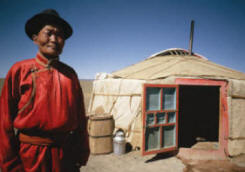 today it
is also a bustling center of a market economy that is developing at a
rapid pace and a civil society with roots in a democratic legacy passed
down from the time of Ghengis Khan. Participants meet with people
involved in this economic and social transformation and seek to
understand both their challenges and successes.
today it
is also a bustling center of a market economy that is developing at a
rapid pace and a civil society with roots in a democratic legacy passed
down from the time of Ghengis Khan. Participants meet with people
involved in this economic and social transformation and seek to
understand both their challenges and successes.
Following this,
the program moves to the
South Gobi
where we travel in the footsteps of the nomadic herders. Mongolia is
one of the last horse-based nomadic cultures left in the world today.
Through encounters with nomadic families, village leaders, school
children and entrepreneurs we gain a rare glimpse of a culture which
dates back to the 12th century and search for answers as to how it will
survive the influence of globalization and progress.
Mongolia is undergoing
a transformation as dramatic as its neighbors: China and Russia, yet it is
unique. Its democratically elected government is steering it towards a
capitalist market economy but it has not been easy. After the initial shock of
the soviet withdrawal and the loss of aid and economic support, Mongolia was
plunged into economic depression, high unemployment and inflation, foreign debt,
poverty and resentment. Yet today it is transforming itself and there is a
renewed national spirit and sense of empowerment.
“Nomads are closer to the created world of God” wrote the Arab historian
and philosopher Ibn Kkaldun, “and removed from the blameworthy customs
that have infected the hearts of settlers”. He believed that they alone
escape the cycles of decadence that infected all civilization. Only
regular blasts of their cleansing winds allowed civilization to sustain
its own virtues.
- from In The Empire of Ghengis Khan by
Stanley Stewart
Mongolia's relationship
with its neighbors reaches back thousands of years. At the time of the Tang
Dynasty in China (618-907AD) Mongolia was ruled by the Uighurs, of Turkic origin,
who came to the aid of the Tang Dynasty during some of its most violent years.
The Uighurs led Mongolia until they were taken over by the Kyrgycs in 840.
Mongolia remained a loose confederation of nomadic clans until Ghengis Khan the
"universal king" united most of the Mongolian tribes and created the world's
largest empire from Korea to Hungary. His grandson, Kublai Khan, was to finish
his work by invading China at the time of the Southern Song Dynasty (with its
capital in Hangzhou) and became the emperor of the Yuan Dynasty in China
(1271-1368). The legacy of the Mongol empire was limited, while no great
cities, art, architecture or culture remains to the extent of other empires, the
Pax Mongolica which lasted a hundred years opened up safe trade routes and
markets across the world. Europe was connected to Asia for the first time. The
Mongols provoked change and disruption in the societies they encountered and the
seeds of globalization were sewn.
Proposed Itinerary
Saturday, April 23: Meet and depart from
Beijing
Day 1: Ulaan Baatar
The contrast between ancient traditions and the dawning of a 21st century
democracy is most visible in Ulaan Baatar where traditional gers and Buddhist
monasteries coexist with modern high-rises. Upon arrival at the airport, we will
be met by our local guides and transferred to the Ulaan Baatar Hotel, a
comfortable, centrally located hotel within walking distance of various museums
and shops. Meet with an organization integrally involved in the development of
Mongolia's civil society and growing industries.
Day 2: Gobi/ Flaming Cliffs
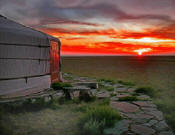 In the morning, fly over vast steppe land to the South Gobi, Mongolia's
southernmost province of semi-arid desert. Contrary to the sterile sameness that
the word "desert" suggests, the Gobi holds many fascinations.
In the morning, fly over vast steppe land to the South Gobi, Mongolia's
southernmost province of semi-arid desert. Contrary to the sterile sameness that
the word "desert" suggests, the Gobi holds many fascinations.
Upon arrival, drive to Three Camel Lodge next to the Gobi Gurvansaikhan National
Park, where our ger camp is located. The park contains mountains (2,815 m),
dinosaur fossils, extraordinary sand dunes, rock formations and Yoliin Am
(vulture valley) which has ice for most of the year. The park is home to over
200 species of birds, including the Mongolian Desert Finch, Cinerous Vulture,
Desert Warbler and Houbara Bustard. The sparse vegetation manages to support
black-tailed gazelle, ibex, argali sheep, Bactrian camels, Argali
mountain sheep, golden eagles, Saker falcons, jerboas and most elusive mammals
such as the dhole, snow leopard and Gobi Bear.
Travel to the legendary Flaming Cliffs, named for
its glowing orange rock. It was here, in 1922, that Dr. Roy Chapman Andrews and
his team from the American Museum of Natural History found the first nest of
dinosaur eggs the world had ever seen. Meet and speak with a Mongolian
paleontologist and learn about recent developments in Mongolia and what this
means for the world of science today.
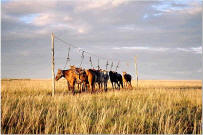
Overnight in gers, the traditional felt tents of
nomadic herders. Made of a latticed wood structure covered with layers of felt
and canvas, each ger is heated by a wood stove and furnished with beautifully
painted wood-framed beds. The camp ie equipped with a restaurant and
western-style toilet and shower facilities. Gers provide an authentic and
memorable taste of Mongolian culture and allow you to visit areas which
otherwise lack traveler accommodations.
Day 3: Bulga sum
Drive to Bulgan sum (town of Bulgan), a local settlement established near a natural spring.
Meet the governor of the sum (county center), the Bulgan sum is one of
the major counties of South Gobi province and learn of the challenges
now facing the nomadic people of the Gobi. Visit the local elementary
school with a dormitory for nomadic children as we learn more about the
people that inhabit this area.
Day 4: Boginy Hyar
Mountian
Spend this morning visiting a nomad family to witness the daily life of Gobi
nomads. Camel riding is an option. In the afternoon, join the environmental
study group of students on a hike in the Altai Mountains bordering the Gobi.
Day 5: Dalanzadgad
(capital of South Gobi province)
Spend the day meeting with foreign investors and those responsible for turning
around one of Mongolia's struggling financial institutions. What is the outlook
for the Mongolian economy and the companies operating in it? What role have
foreign investors played in this?
Day 6: Ulaan
Bataar
After breakfast transfer to local airport for flight to Ulaan Baatar. Afternoon
in the countryside to visit the summer palace of the Bodh Khan (Mongolian
version of
Dalai Lama) and optional horseback riding. Participants learn from hoomi throat
singers.
Day 7: Ulaan Baatar to Beijing
Participants return to Beijing where they may do their own sightseeing,
shopping and make connections to international flights.
 today it
is also a bustling center of a market economy that is developing at a
rapid pace and a civil society with roots in a democratic legacy passed
down from the time of Ghengis Khan. Participants meet with people
involved in this economic and social transformation and seek to
understand both their challenges and successes.
today it
is also a bustling center of a market economy that is developing at a
rapid pace and a civil society with roots in a democratic legacy passed
down from the time of Ghengis Khan. Participants meet with people
involved in this economic and social transformation and seek to
understand both their challenges and successes. 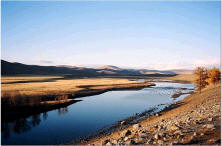
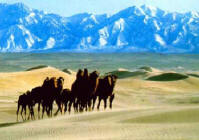
 In the morning, fly over vast steppe land to the South Gobi, Mongolia's
southernmost province of semi-arid desert. Contrary to the sterile sameness that
the word "desert" suggests, the Gobi holds many fascinations.
In the morning, fly over vast steppe land to the South Gobi, Mongolia's
southernmost province of semi-arid desert. Contrary to the sterile sameness that
the word "desert" suggests, the Gobi holds many fascinations. 